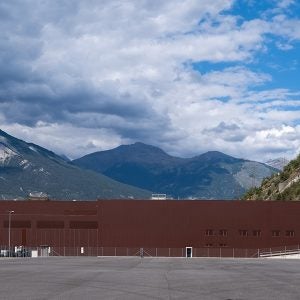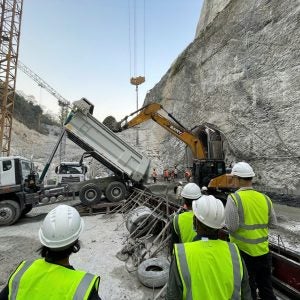
The latest issue of Dam Engineering (Volume XXIV, Issue 2) has been published. Released in May, the independent, peer-reviewed journal includes three technical papers (abstracts below).
Sheetpiles Driven into Canal Banks to Lower Seepage Losses, by Ashraf A Ahmed, Cathal Sweeney, Hassan Ahmed & A Mashal
This research investigates the introduction of curtain walls to canal or river banks in order to assess its effect on the exit hydraulic gradient and uplift force acting on hydraulic structures. A computer model utilising the finite element method was used, and four different shaped canal banks were studied. It was found that the introduction of a curtain wall into the middle of the canal bank had no appreciable effect on reducing the uplift force or exit hydraulic gradient. In comparison, the introduction of an inner edge curtain wall proved to be far more effective, where reductions of up to 23% in uplift force, and a maximum reduction of 52% in exit hydraulic gradient, were obtained. Curtain walls or cores, having permeability that equalled 50% of the canal/river bank permeability, had no appreciable effect on uplift force and exit hydraulic gradient even when placed at the inner edge of the canal. It was found that 2D analysis of seepage is inaccurate in some cases as it underestimates flow, exit hydraulic gradient, and uplift force on hydraulic structures.
Modelling Issues in the Seismic Analysis of Concrete Gravity Dams, by Arnab Banerjee, D K Paul & R N Dubey
Modelling issues in the seismic analysis of dams are challenging. This paper addresses the various modelling issues of a concrete gravity dam, with the help of various field problems. The issues regarding the modelling of these types of dams, e.g. infinite reservoir with truncated boundaries, and semi-infinite soil medium with finite domain, are discussed. The issues related to the input motion of earthquake excitation are also considered, a comparative study of different modelling issues has been made, and the appropriate modelling of a dam-reservoir-foundation system, along with suitable simulation of seismic input, has been suggested for the evaluation of a dam’s response.
A Comparison Between 2D and 3D Seepage Analysis Results in Earth Dams Constructed in Narrow Valleys (Case Study: Haaleh Dam), by Nazanin Yarahmadi
The most common method used in seepage analysis of earth dams is performing a 2D analysis on the maximum cross-section, and generalizing its results to the third dimension. As a normal consequence of this method the effect of the valley shape, and changes in material properties along the third dimension, are ignored. In this research both 2D and 3D transient seepage analyses have been performed, using the Haaleh Dam in Iran as a case study. The results have then been compared with the values obtained via instrumentation, which reveal that 2D and 3D seepage analyses show acceptable conformity with the instrumentation results in the first few months after the start of impoundment. However, by elapsing the time needed by the dam’s body and foundation materials to become saturated, 3D analysis results continue to show conformity with the instrumentation results, but the results of the 2D seepage analysis lose this concordance, and the difference between 2D analysis and instrumentation results increases.
Contact us for more information
For information on submitting papers, or for more details about subscribing to Dam Engineering, contact: Tracey Honney, Content Manager, Dam Engineering, Progressive House, Maidstone Road, Foots Cray, Sidcup, Kent DA14 5HZ. Tel: +44 20 8269 7767 fax: +44 208 269 7804, Email: thonney@progressivemediagroup.com.






